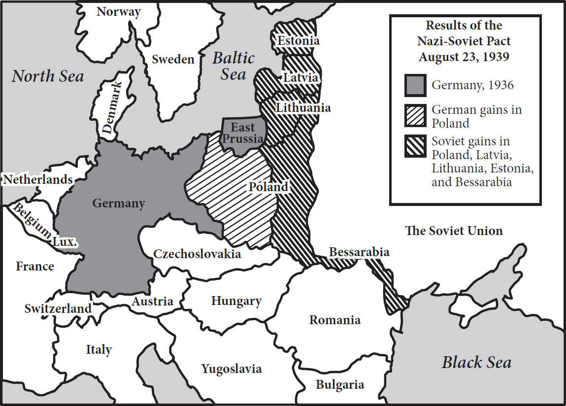New SAT Reading Practice Test 2
Bộ sưu tập: SAT Practice Test
Số câu hỏi: 1 câuSố mã đề: 1 đềThời gian: 1 giờ
196,883 lượt xem 15,140 lượt làm bài
By the end of 1939 Soviet troops had forced their
Way into garrisons in the Baltic states of Estonia,
Latvia, and Lithuania. In 1940 the Soviets forcibly
annexed the three Baltic states into the USSR.
Line 5 But in 1941 Hitler double-crossed Stalin: he launched an attack on the Soviet Union. The Baltic nations Were
caught in the middle of the treachery. In 1945, when
the War ended, Estonia remained occupied by the Soviets.
10 After nearly 50 years of Soviet occupation, when
agitations for independence came in the late 1980s,
the protestors pointed back to the Molotov-Ribbentrop
Pact, a secret non-aggression treaty between
the Soviet Union and Nazi Germany. If the Kremlin were
15 to acknowledge the existence of this protocol, they
reasoned, it would be admitting that the Baltic States
had no legal "marriage" with Moscow, but that these
nations were forcibly abducted with the collusion
of the World's most heinous fascist regime. So the
20 occupied nations had every right to ask for their
freedom, and with no need for a legal "divorce.”
The Baltic states had been morally supported with
the firm stand taken in 1940 by the United States not
to recognize the legality of the forceful annexation
25 of Estonia, Latvia, and Lithuania. But politics Were
effective only if the Estonians had some other leverage.
A nation of barely one million, burdened with half
a million foreign settlers and 100,000 Soviet troops,
could not threaten the Soviet Union militarily or
30 economically, so it had to do it with the force of its
culture. Estonia had always been a nation of singers.
Its wealth of folk songs gave rhythm to village life
and Work, and its earnest anthems often invoked the
longing for self-determination. Estonians had lived for
35 centuries in servitude, and the themes of their music
were often grim: sorrow, slavery, soil, blood, birch
forests, and sacrifice. But there was always hope in
their hearts.
Early in their national awakening, about 140 years
40 ago, Estonians established a history of mass song
festivals, held when money and politics allowed
celebrations that would kindle and fortify the courage
to express their love of language and nation, and their
reluctance to be absorbed by anyone. The festivals were
45 a nationwide phenomenon, as Were similar
festivals held in Latvia and Lithuania.
In Tallinn the massive modern song stage held
some 30,000 singers and the outdoor amphitheater
could accommodate as many as 300,000. Often, 30
50 percent of all Estonians Would be there-at a single concert. During the Soviet years the festivals were
forced to pay tribute to Communist icons and the
solidarity of the Soviet peoples. Choirs from other
parts of the vast empire Would come and all Would
55 whip up a rousing tribute to Stalin or Lenin. To these mandatory performances Estonians Would introduce
patriotic songs disguised as love songs or folk music.
An unofficial national anthem, by the popular choir
director Gustav Ernesaks, established itself in 1947,
60 and survived the entire Soviet occupation despite a serious attempt by officials to eliminate it in 1969.
By the late 1980s the nation was simmering. A
movement of young historians Was already defying
Soviet authority in speeches that laid history bare under
65 the cover of Gorbachev's policy of glasnost, or "free speech." And the burden of protest songs had passed to
rock-and-rollers, young men whose energized patriotic
tunes blared from every radio.
Momentum built to a Crescendo in the Summer
70 of 1988 when a rock concert in Tallinn's Old Town
spilled into the Song Festival grounds and massive
crowds gathered for six straight nights to lift arms,
SWay in unison, and sing patriotic songs. Emboldened,
Estonians brought out forbidden blue-and-black-and
75 White national flags, some from attics and basements
where they had been hidden since 1940. Shockingly, no
one stopped them. For the finale of these "Night Song
Festivals" more than 200,000 Estonians gathered.
This was the heart of "The Singing Revolution."
80 a spontaneous, non-violent, but powerful political
movement that united Estonians With poetry and
music. After that there Was no backing up. Sedition
hung in the Wind, Waiting to be denied.

The point of view from which the passage is written is best described as
condemnatory of the Soviet Union's treacherous actions.
sympathetic to the Baltic states' struggle for freedom.
dismissive of the idea of non-violent revolution.
conflicted about the underlying cause of the revolution.
As used in line 18, “collusion” most nearly means
conspiracy.
impact.
separation.
danger.
In lines 33-36, the author draws a distinction between
the tone of Estonian songs and the people's true feelings.
the themes of Estonian folk songs and anthems.
the military strength of Estonia and that of the Soviet Union.
song festivals in Estonia and those in Latvia and Lithuania.
In the context of the passage, the phrase “their reluctance to be absorbed” suggests that Estonians
refused to speak Russian with the many foreigners settlers in Estonia.
wanted to have an independent nation.
worked to ensure their culture stayed distinct from those of the other Baltic states.
were unwilling to devote the amount of concentration to song festivals that the Soviets demanded.
The author includes statistics about the size of the song stage in Tallinn (lines 47-49) primarily to
provide a sense of how large the amphitheater is.
indicate the popularity of the tributes to Stalin and Lenin.
compare the size to that of similar stages in Latvia and Lithuania.
illustrate the wide appeal of the mass song festivals in Estonia.
As used in line 66, “burden” most nearly means
weight.
travail.
responsibility.
need.
The primary rhetorical effect of the last sentence of the passage is to
convey the sense of dread that hung over Estonia at the height of the Singing Revolution.
indicate the depth of disagreement between violent and non-violent revolutionaries.
show how crucial music and poetry were to Estonia's fight for independence.
communicate the sense of optimistic tension that Estonians felt after the Night Song Festivals.
Which of the following does the passage suggest about Estonia’s relation to the Soviet Union?
Estonia had a richer cultural tradition of singing than the Soviet Union had.
Estonia had the political leverage necessary to free itself from the Soviet Union.
Estonia was smaller and weaker than the Soviet Union, making violent revolution impractical.
Estonia held song festivals during the Soviet occupation primarily to pay tribute to Communist icons.
The author implies which of the following about Estonian song festivals?
They afforded Estonians a medium through which national and cultural pride could be expressed.
They were started during the Soviet occupation to preserve Estonian culture and language.
They were unique in size and format to the country where they were founded.
They provided an opportunity to sing songs that were more uplifting than those sung while working.
Which choice provides the best evidence for the answer to the previous question?
Lines 19-21 ("So…'divorce'")
Lines 44-46 ("The festivals…Lithuania")
Line 62 ("By the late…simmering")
Lines 79-82 ("This…music")
Which of the following claims is supported by the diagram?
In the 1939 pact, Germany gained the entirety of Poland.
The Soviet Union doubled in size after the pact.
Lithuania and Estonia are contiguous countries.
The Soviet Union's gains stretched from the Baltic Sea to the Black Sea.
1,328 xem
1 mã đề 1 câu hỏi
1 mã đề 1 câu hỏi
1 mã đề 1 câu hỏi
1 mã đề 1 câu hỏi
1 mã đề 1 câu hỏi

